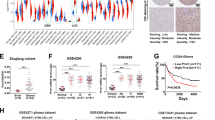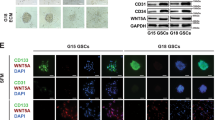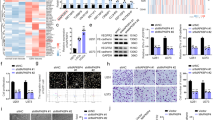Abstract
Oligodendroglioma is an important type of lower-grade glioma (LGG), which is a slowly progressing brain tumor. Many LGGs eventually transform into a more aggressive or malignant type. Enhanced angiogenesis is a characteristic of malignantly transformed oligodendroglioma (m-oligodendroglioma). However, the pathogenesis and signaling pathways associated with angiogenesis and proliferation in m-oligodendroglioma are not well understood. In this study, we identified that Insulin Gene Enhancer Protein (ISL2) and its angiogenic capacity were inversely related to survival according to LGG patient data from an online database, and this was further confirmed with pathological LGG patient samples, including malignantly transformed samples, by detecting the expression of ISL2, the angiogenic markers vascular endothelial growth factor (VEGFA) and CD31 and the proliferation marker Ki-67. We then established novel oligodendroglioma patient tumor-derived orthotopic xenograft mouse models and cell lines to verify the role of ISL2 in regulating angiogenesis to promote oligodendroglioma growth and malignant transformation. Furthermore, ISL2 regulated ANGPT2 transcription by binding to the ANGPT2 promoter. Then, ANGPT2, a downstream gene, activated angiogenesis through VEGFA to promote oligodendroglioma malignant transformation. Finally, combining AAV-ISL2-shRNA with temozolomide suppressed oligodendroglioma progression more effectively than either monotherapy in vivo and in vitro. Thus, hypoxia-induced ISL2 regulated ANGPT2, which subsequently induced angiogenesis to promote oligodendroglioma growth and malignant transformation. Malignancy was accompanied by worsened hypoxia inside the tumor mass, creating a positive feedback loop. In conclusion, this study suggests that ISL2 is a biomarker for oligodendroglioma progression and that anti-ISL2 therapy may offer a potential clinical strategy for treating m-oligodendroglioma.
This is a preview of subscription content, access via your institution
Access options
Subscribe to this journal
Receive 50 print issues and online access
$259.00 per year
only $5.18 per issue
Buy this article
- Purchase on Springer Link
- Instant access to full article PDF
Prices may be subject to local taxes which are calculated during checkout






Similar content being viewed by others
References
Feller C, Felix M, Weiss T, Herold-Mende C, Zhang F, Kockmann T, et al. Histone epiproteomic profiling distinguishes oligodendroglioma, IDH-mutant and 1p/19q co-deleted from IDH-mutant astrocytoma and reveals less tri-methylation of H3K27 in oligodendrogliomas. Acta Neuropathol. 2019;139:211–13.
van den Bent MJ, Chang SM. Grade II and III oligodendroglioma and astrocytoma. Neurologic Clin. 2018;36:467–84.
Eckel-Passow JE, Lachance DH, Molinaro AM, Walsh KM, Decker PA, Sicotte H, et al. Glioma groups based on 1p/19q, IDH, and TERT promoter mutations in tumors. N Engl J Med. 2015;372:2499–508.
Louis DN, Perry A, Reifenberger G, von Deimling A, Figarella-Branger D, Cavenee WK, et al. The 2016 World Health Organization classification of tumors of the central nervous system: a summary. Acta Neuropathol. 2016;131:803–20.
Suzuki H, Aoki K, Chiba K, Sato Y, Shiozawa Y, Shiraishi Y, et al. Mutational landscape and clonal architecture in grade II and III gliomas. Nat Genet. 2015;47:458–68.
Weller M, Wick W, Aldape K, Brada M, Berger M, Pfister SM, et al. Glioma. Nat Rev Dis Prim. 2015;1:15017.
Ohgaki H, Kleihues P. The definition of primary and secondary glioblastoma. Clin Cancer Res. 2013;19:764–72.
Weller M, van den Bent M, Tonn JC, Stupp R, Preusser M, Cohen-Jonathan-Moyal E, et al. European Association for Neuro-Oncology (EANO) guideline on the diagnosis and treatment of adult astrocytic and oligodendroglial gliomas. Lancet Oncol. 2017;18:e315–29.
Wesseling P, van den Bent M, Perry A. Oligodendroglioma: pathology, molecular mechanisms and markers. Acta Neuropathol 2015;129:809–27.
Stupp R, Hegi ME, Mason WP, van den Bent MJ, Taphoorn MJ, Janzer RC, et al. Effects of radiotherapy with concomitant and adjuvant temozolomide versus radiotherapy alone on survival in glioblastoma in a randomised phase III study: 5-year analysis of the EORTC-NCIC trial. Lancet Oncol. 2009;10:459–66.
Gagliardi F, Narayanan A, Gallotti AL, Pieri V, Mazzoleni S, Cominelli M, et al. Enhanced SPARCL1 expression in cancer stem cells improves preclinical modeling of glioblastoma by promoting both tumor infiltration and angiogenesis. Neurobiol Dis. 2019;134:104705.
Seano G, Jain RK. Vessel co-option in glioblastoma: emerging insights and opportunities. Angiogenesis. 2019;23:9–16.
Krenzlin H, Behera P, Lorenz V, Passaro C, Zdioruk M, Nowicki MO, et al. Cytomegalovirus promotes murine glioblastoma growth via pericyte recruitment and angiogenesis. J Clin Investig. 2019;130:1671–83.
Yazdani Y, Sharifi Rad MR, Taghipour M, Chenari N, Ghaderi A, Razmkhah M. Genistein Suppression of Matrix Metalloproteinase 2 (MMP-2) and Vascular Endothelial Growth Factor (VEGF) expression in mesenchymal stem cell like cells isolated from high and low grade gliomas. Asian Pac J Cancer Prev. 2016;17:5303–7.
Osterberg N, Ferrara N, Vacher J, Gaedicke S, Niedermann G, Weyerbrock A, et al. Decrease of VEGF-A in myeloid cells attenuates glioma progression and prolongs survival in an experimental glioma model. Neuro Oncol. 2016;18:939–49.
Vallée A, Guillevin R, Vallée J-N. Vasculogenesis and angiogenesis initiation under normoxic conditions through Wnt/β-catenin pathway in gliomas. Rev Neurosci. 2018;29:71–91.
Onishi M, Ichikawa T, Kurozumi K, Date I. Angiogenesis and invasion in glioma. Brain Tumor Pathol. 2011;28:13–24.
Esencay M, Sarfraz Y, Zagzag D. CXCR7 is induced by hypoxia and mediates glioma cell migration towards SDF-1α. BMC Cancer 2013;13:347.
Alfonso JCL, Talkenberger K, Seifert M, Klink B, Hawkins-Daarud A, Swanson KR, et al. The biology and mathematical modelling of glioma invasion: a review. J R Soc. 2017;14:20170490.
Kaur B, Khwaja FW, Severson EA, Matheny SL, Brat DJ, Van Meir EG. Hypoxia and the hypoxia-inducible-factor pathway in glioma growth and angiogenesis. Neuro Oncol. 2005;7:134–53.
Bachy I, Failli V, Retaux S. A LIM-homeodomain code for development and evolution of forebrain connectivity. Neuroreport. 2002;13:A23–7.
Shirasaki R, Pfaff SL. Transcriptional codes and the control of neuronal identity. Annu Rev Neurosci. 2002;25:251–81.
Edqvist PH, Myers SM, Hallbook F. Early identification of retinal subtypes in the developing, pre-laminated chick retina using the transcription factors Prox1, Lim1, Ap2alpha, Pax6, Isl1, Isl2, Lim3 and Chx10. Eur J Histochem. 2006;50:147–54.
Kay RB, Triplett JW. Visual neurons in the superior colliculus innervated by Islet2(+) or Islet2(−) retinal ganglion cells display distinct tuning properties. Front Neural Circuits. 2017;11:73.
Gill GN. Decoding the LIM development code. Trans Am Clin Climatol Assoc. 2003;114:179–89.
Scholz A, Plate KH, Reiss Y. Angiopoietin-2: a multifaceted cytokine that functions in both angiogenesis and inflammation. Ann N Y Acad Sci. 2015;1347:45–51.
Chen Z, Zhu S, Hong J, Soutto M, Peng D, Belkhiri A, et al. Gastric tumour-derived ANGPT2 regulation by DARPP-32 promotes angiogenesis. Gut 2016;65:925–34.
Wang X, He C, Hu X. LIM homeobox transcription factors, a novel subfamily which plays an important role in cancer (review). Oncol Rep. 2014;31:1975–85.
Fuchs Q, Pierrevelcin M, Messe M, Lhermitte B, Blandin AF, Papin C, et al. Hypoxia inducible factors’ signaling in pediatric high-grade gliomas: role, modelization and innovative targeted approaches. Cancers. 2020;12.
Schiffer D, Mellai M, Bovio E, Bisogno I, Casalone C, Annovazzi L. Glioblastoma niches: from the concept to the phenotypical reality. Neurological Sci. 2018;39:1161–8.
Shim WS, Ho IA, Wong PE. Angiopoietin: a TIE(d) balance in tumor angiogenesis. Mol Cancer Res. 2007;5:655–65.
Podbielska M, Szulc ZM, Kurowska E, Hogan EL, Bielawski J, Bielawska A, et al. Cytokine-induced release of ceramide-enriched exosomes as a mediator of cell death signaling in an oligodendroglioma cell line. J Lipid Res. 2016;57:2028–39.
Post GR, Dawson G. Characterization of a cell line derived from a human oligodendroglioma. Mol Chem Neuropathol. 1992;16:303–17.
Swanson KR, Rockne RC, Claridge J, Chaplain MA, Alvord EC Jr., Anderson AR. Quantifying the role of angiogenesis in malignant progression of gliomas: in silico modeling integrates imaging and histology. Cancer Res. 2011;71:7366–75.
Chaudhry IH, O’Donovan DG, Brenchley PE, Reid H, Roberts IS. Vascular endothelial growth factor expression correlates with tumour grade and vascularity in gliomas. Histopathology. 2001;39:409–15.
Karamysheva AF. Mechanisms of angiogenesis. Biochem Biokhimiia. 2008;73:751–62.
Marti Nez-Gonzalez A, Calvo GF, Ayuso JM, Ochoa I, Fernandez LJ, Perez-Garcia VM. Hypoxia in gliomas: opening therapeutical opportunities using a mathematical-based approach. Adv Exp Med Biol. 2016;936:11–29.
Heindryckx F, Gerwins P. Targeting the tumor stroma in hepatocellular carcinoma. World J Hepatol. 2015;7:165–76.
Fischer I, Gagner JP, Law M, Newcomb EW, Zagzag D. Angiogenesis in gliomas: biology and molecular pathophysiology. Brain Pathol. 2005;15:297–310.
Wang M, Zhao X, Zhu D, Liu T, Liang X, Liu F, et al. HIF-1α promoted vasculogenic mimicry formation in hepatocellular carcinoma through LOXL2 up-regulation in hypoxic tumor microenvironment. J Exp Clin Cancer Res. 2017;36:60.
Chinot OL, Wick W, Mason W, Henriksson R, Saran F, Nishikawa R, et al. Bevacizumab plus radiotherapy-temozolomide for newly diagnosed glioblastoma. N Engl J Med. 2014;370:709–722.
Reyes-Botero G, Cartalat-Carel S, Chinot OL, Barrie M, Taillandier L, Beauchesne P, et al. Temozolomide plus bevacizumab in elderly patients with newly diagnosed glioblastoma and poor performance status: an ANOCEF phase II trial (ATAG). Oncologist. 2018;23:e524–44.
van den Bent MJ, Klein M, Smits M, Reijneveld JC, French PJ, Clement P, et al. Bevacizumab and temozolomide in patients with first recurrence of WHO grade II and III glioma, without 1p/19q co-deletion (TAVAREC): a randomised controlled phase 2 EORTC trial. Lancet Oncol. 2018;19:1170–9.
Zhang XD, Baladandayuthapani V, Lin H, Mulligan G, Li B, Esseltine DW, et al. Tight junction protein 1 modulates proteasome capacity and proteasome inhibitor sensitivity in multiple myeloma via EGFR/JAK1/STAT3 signaling. Cancer Cell. 2016;29:639–52.
Qi L, Sun X, Li FE, Zhu BS, Braun FK, Liu ZQ, et al. HMGB1 promotes mitochondrial dysfunction-triggered striatal neurodegeneration via autophagy and apoptosis activation. PLoS ONE. 2015;10:e0142901.
Tang Z, Li C, Kang B, Gao G, Li C, Zhang Z. GEPIA: a web server for cancer and normal gene expression profiling and interactive analyses. Nucleic Acids Res. 2017;45:W98–102.
Acknowledgements
This work was supported in part by the National Natural Science Foundation of China (grant nos. 81970191, 31971161, 31971224, and 81301978), the Guangdong Natural Science Foundation of China (grant nos. 2018A0303130090 and 2019A1515011332), the Youth Medical Doctors Project of Jiangsu Province of China (QNRC2016870), and the Fundamental Research Funds for the Central Universities of China (grant no. 19ykpy149).
Author information
Authors and Affiliations
Corresponding author
Ethics declarations
Conflict of interest
The authors declare that they have no conflict of interest.
Additional information
Publisher’s note Springer Nature remains neutral with regard to jurisdictional claims in published maps and institutional affiliations.
Supplementary information
Rights and permissions
About this article
Cite this article
Qi, L., Wang, ZY., Shao, XR. et al. ISL2 modulates angiogenesis through transcriptional regulation of ANGPT2 to promote cell proliferation and malignant transformation in oligodendroglioma. Oncogene 39, 5964–5978 (2020). https://doi.org/10.1038/s41388-020-01411-y
Received:
Revised:
Accepted:
Published:
Issue Date:
DOI: https://doi.org/10.1038/s41388-020-01411-y
This article is cited by
-
The evaluation of six genes combined value in glioma diagnosis and prognosis
Journal of Cancer Research and Clinical Oncology (2023)
-
Single-cell transcriptomic analysis of eutopic endometrium and ectopic lesions of adenomyosis
Cell & Bioscience (2021)



